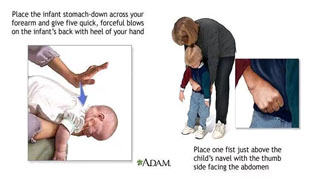What should I do?
Digging by hand? Shoot hard? Cough desperately?
These methods are not advisable!
Timely and correct treatment of airway foreign body obstruction, mastering the Heimlich emergency method, may save a precious life.
In what situations can it be used?
The Heimlich emergency method can be applied to patients with partial or complete airway obstruction. Specifically, it can be divided into the following four situations.
Firstly, when a patient coughs forcefully but stops coughing and produces wheezing sounds, or when the patient is unable to speak or cough, presents a painful expression, and pinches their neck in a "V" shape with their hand, the patient should be immediately asked if there is a foreign body obstruction in the respiratory tract, and the Heimlich emergency method should be applied according to the patient's condition.
Secondly, when witnessing a patient inhaling foreign objects and experiencing symptoms of breathing difficulties, the Heimlich emergency method can be implemented.
Thirdly, for patients who are still unable to receive effective ventilation after opening the airway and experience symptoms such as facial color, lips turning blue, and loss of consciousness, it can also be judged as obstruction of respiratory foreign bodies. Heimlich emergency treatment should be immediately implemented.
Fourthly, for drowning patients, this method can also be used to expel fluid from their respiratory tract.
How to operate?
According to the different physical characteristics of different age groups, it can be divided into the following situations.

The first step is to immediately pick up the child and have the child lie on the parent's arm, face down; Pinch both sides of the child's cheekbones with your hands to ensure that their mouth is open; Then use the palm root of the other hand to continuously pat the child's back between the two shoulder blades 1-5 times, so that the foreign object stuck in the trachea will fall out of the child's mouth.
Step 2, if you pat your back 5 times and the foreign object hasn't been expelled yet, quickly flip the child over, face up, and tilt your head slightly downwards; Then use the index and middle fingers to quickly press upwards continuously 5 times at the position of the child's sternum (just below the line connecting the two nipples) until the foreign body in the trachea is expelled. When pressing, pay attention to grasping the strength, with a balance between firmness and softness.
From 3 years old and above to adults
The first responder first stands firmly in a posture of "front leg arched and back leg kicked", then sits the patient on their arched thighs and tilts their body slightly forward; Then extend both arms forward from the patient's armpits and wrap them around the patient; Grasp the fist with the left hand and the wrist with the right hand from the front of the patient, so that the tiger's mouth of the left fist is pressed against the center of the upper abdomen below the patient's chest and above the navel, forming a "encirclement" posture; Then suddenly tighten both arms with force, and use the left fist to forcefully apply pressure to the patient's upper abdomen, forcing the upper abdomen to sink and the abdominal contents to move upwards, causing the diaphragm to rise and compress the lungs and bronchi.
Each impact can provide a certain amount of air to the airway, thereby flushing foreign objects out of the trachea. After applying pressure, immediately relax your arms and repeat the operation until the foreign object is expelled.
If there is no one around when acute respiratory foreign body obstruction occurs, the person being rescued can also perform abdominal impact using the same technique, or press the upper abdomen against a hard and protruding object, and repeat the process until the foreign body is expelled.
Key techniques - scissors, stone, cloth
Scissors: Two fingers together, like a closed pair of scissors. The pressing point of the Heimlich emergency method is located two or more horizontal fingers above the navel. First, locate the position of the patient's navel, and then place the two fingers together horizontally above the navel to find the pressing point.
Stone: Refers to the fist. Clench your fist with one hand and place the eye of your thumb on the pressing point.
Bu: It refers to using the other hand to hold a fist and then using upward and inward force to impact the patient's upper abdomen.
There are 5 things to note, don't be careless
Regarding the Heimlich first aid method, there are some precautions. Finally, I will explain them to everyone.
(1) The "three cannot" and "V-shaped hand" are quick and easy identification methods for Heimlich signs. The so-called "three cannot" refers to the inability of patients to speak, breathe, or cough after foreign objects block the trachea. "V-shaped hand" refers to the involuntary appearance of "V-shaped" hands tightly grasping one's throat when a patient experiences "three cannot".
(2) For patients with extreme obesity and respiratory foreign body blockage in late pregnancy, the chest impact method should be used, with the posture unchanged. Simply place the tiger's mouth of the left hand against the lower end of the patient's sternum. If the operation deviates from the sternum, it may cause rib fractures.
(3) The Heimlich first aid method is only applicable to the inhalation airway of foreign objects and cannot be used for emergency treatment of esophageal foreign objects. It should not be used on people who appear to have airway obstruction but can still speak and breathe.
(4) If the patient has already experienced cardiac arrest, the routine steps of cardiopulmonary resuscitation should be prioritized to avoid delaying the time of cardiopulmonary resuscitation.
(5) Once the Heimlich emergency method fails to expel the foreign object and the patient's coughing and breathing difficulties continue, they should be immediately sent to the hospital for emergency treatment or call 120 emergency hotline.


